118 results
5 - How Do Drugs Cause Harm?
-
- Book:
- How to Talk to Your Child About Drugs
- Published online:
- 13 February 2025
- Print publication:
- 06 March 2025, pp 72-97
-
- Chapter
- Export citation
5 - The Persistence of Dependence
- from Part III - Liberty as Independence: The Ideal Betrayed
-
- Book:
- Liberty as Independence
- Published online:
- 23 January 2025
- Print publication:
- 06 February 2025, pp 119-140
-
- Chapter
- Export citation

Liberty as Independence
- The Making and Unmaking of a Political Ideal
-
- Published online:
- 23 January 2025
- Print publication:
- 06 February 2025

Metaphysics of Causation
-
- Published online:
- 03 January 2025
- Print publication:
- 16 January 2025
-
- Element
-
- You have access
- Open access
- HTML
- Export citation
Why Are Experts Correlated? Decomposing Correlations Between Judges
-
- Journal:
- Psychometrika / Volume 74 / Issue 3 / September 2009
- Published online by Cambridge University Press:
- 01 January 2025, pp. 531-553
-
- Article
- Export citation
On dual risk models with proportional gains and dependencies
-
- Journal:
- Probability in the Engineering and Informational Sciences , First View
- Published online by Cambridge University Press:
- 23 December 2024, pp. 1-32
-
- Article
-
- You have access
- Open access
- HTML
- Export citation

Time Series for Economics and Finance
-
- Published online:
- 19 December 2024
- Print publication:
- 19 December 2024
-
- Textbook
- Export citation
2 - Stationarity and Mixing
-
- Book:
- Time Series for Economics and Finance
- Published online:
- 19 December 2024
- Print publication:
- 19 December 2024, pp 14-41
-
- Chapter
- Export citation

Embodiment, Dependence, and God
-
- Published online:
- 15 December 2024
- Print publication:
- 19 December 2024
-
- Element
- Export citation
13 - Probabilistic Entanglement of Quantum Observables
- from Part IV - Contextual Entanglement in Quantum and Classical Physics
-
- Book:
- Contextual Reinterpretation of Quantum Nonlocality
- Published online:
- 28 November 2024
- Print publication:
- 05 December 2024, pp 149-164
-
- Chapter
- Export citation
Multivariate regularly varying insurance and financial risks in multidimensional risk models
- Part of
-
- Journal:
- Journal of Applied Probability / Volume 61 / Issue 4 / December 2024
- Published online by Cambridge University Press:
- 13 May 2024, pp. 1319-1342
- Print publication:
- December 2024
-
- Article
-
- You have access
- Open access
- HTML
- Export citation
4 - The Paradox of Republican Emancipation
-
- Book:
- Sharing Freedom
- Published online:
- 28 March 2024
- Print publication:
- 04 April 2024, pp 141-182
-
- Chapter
- Export citation
2 - Christian August Crusius
- from Part I - Pre-Kantian Moral Philosophy
-
- Book:
- Kant's <i>Critique of Practical Reason</i>
- Published online:
- 31 January 2025
- Print publication:
- 28 March 2024, pp 40-43
-
- Chapter
- Export citation
3 - The Citizen–Government Relationship in a Network of Trust Relationships
-
- Book:
- Trust, Courts and Social Rights
- Published online:
- 08 February 2024
- Print publication:
- 15 February 2024, pp 58-82
-
- Chapter
- Export citation
Chapter 8 - Alcohol Misuse
-
-
- Book:
- Seminars in Consultation-Liaison Psychiatry
- Published online:
- 04 January 2024
- Print publication:
- 18 January 2024, pp 117-133
-
- Chapter
- Export citation
5 - Schooling without Learning
- from Part II - Thematic Papers
-
-
- Book:
- Mozambique at a Fork in the Road
- Published online:
- 14 December 2023
- Print publication:
- 21 December 2023, pp 114-135
-
- Chapter
-
- You have access
- Open access
- HTML
- Export citation
Chapter 12 - Illusions of Ethical Independence
-
-
- Book:
- Kierkegaard's <i>Either/Or</i>
- Published online:
- 16 November 2023
- Print publication:
- 30 November 2023, pp 204-220
-
- Chapter
- Export citation
4 - Aquinas’s Account of Creation
-
- Book:
- Theistic Evolution
- Published online:
- 19 October 2023
- Print publication:
- 02 November 2023, pp 127-155
-
- Chapter
- Export citation
22 - Care
- from Part IV - Intimate and Everyday Life
-
-
- Book:
- The Cambridge Handbook for the Anthropology of Ethics
- Published online:
- 11 May 2023
- Print publication:
- 25 May 2023, pp 561-590
-
- Chapter
- Export citation
Chapter 13 - The Story of My Life
- from Section 2 - Reaching the Extreme with Exercise: A Collection of Clinical Case Studies
-
-
- Book:
- The Body in the Mind
- Published online:
- 30 March 2023
- Print publication:
- 06 April 2023, pp 177-184
-
- Chapter
- Export citation

